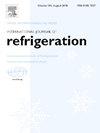Experimental campaign on non-fluorinated refrigerant mixtures in a low-charge heat pump
IF 3.5
2区 工程技术
Q1 ENGINEERING, MECHANICAL
International Journal of Refrigeration-revue Internationale Du Froid
Pub Date : 2025-01-23
DOI:10.1016/j.ijrefrig.2025.01.008
引用次数: 0
Abstract
This work experimentally investigated the energy performance of several non-fluorinated refrigerant mixtures and their pure components on a prototype of a low-refrigerant charge single-stage water-to-water heat pump. The pure refrigerants tested in the unit were Propane (R-290), Propylene (R-1270) and Dimethyl Ether (DME, R-E170). In addition, the tested mixtures were Propane-CO2, Propylene-CO2, DME-CO2, Propylene-DME at different compositions and temperatures. Total refrigerant charge amounts, including auxiliary pipes and valves, ranged between 190 g and 290 g. Heating capacities ranged between 3.7 kW and 12.2 kW. The highest capacities were obtained by Propylene-CO2 [0.93–0.07]. At high source and sink glide conditions, mixing low amounts of CO2 showed performance enhancements, especially on Propylene and DME. Compared to Propane, DME mixed with 5 % CO2, resulted in up to 12 % COP enhancement, 16 % lower capacity, and 50 % higher limit heating capacity (LHC). Propylene and the low-glide mixture Propylene-DME performed well at low source and sink glides compared to Propane. Measurements on the refrigerant cycle also suggest that the circulating composition of the mixture slightly shifted toward the most volatile component. The results suggest that well-designed refrigerant mixtures containing Propylene, DME and CO2 may enhance efficiency, heating capacity, and the heating capacity at maximum charge while maintaining conventional operating pressures and discharge temperatures.
求助全文
约1分钟内获得全文
求助全文
来源期刊
CiteScore
7.30
自引率
12.80%
发文量
363
审稿时长
3.7 months
期刊介绍:
The International Journal of Refrigeration is published for the International Institute of Refrigeration (IIR) by Elsevier. It is essential reading for all those wishing to keep abreast of research and industrial news in refrigeration, air conditioning and associated fields. This is particularly important in these times of rapid introduction of alternative refrigerants and the emergence of new technology. The journal has published special issues on alternative refrigerants and novel topics in the field of boiling, condensation, heat pumps, food refrigeration, carbon dioxide, ammonia, hydrocarbons, magnetic refrigeration at room temperature, sorptive cooling, phase change materials and slurries, ejector technology, compressors, and solar cooling.
As well as original research papers the International Journal of Refrigeration also includes review articles, papers presented at IIR conferences, short reports and letters describing preliminary results and experimental details, and letters to the Editor on recent areas of discussion and controversy. Other features include forthcoming events, conference reports and book reviews.
Papers are published in either English or French with the IIR news section in both languages.

 求助内容:
求助内容: 应助结果提醒方式:
应助结果提醒方式:


